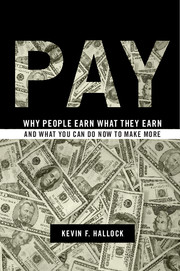Book contents
- Frontmatter
- Contents
- Figures
- Tables
- Acknowledgments
- PART I HOW HARD CAN THIS BE?
- 1 Common Sense, Economics, and HR
- 2 Wages, the Wage Distribution, and Wage Inequality
- 3 The Facts
- 4 The Difference Between Wages and Total Compensation
- PART II HOW ORGANIZATIONS SET PAY STRUCTURE AND WHY
- PART III HOW PEOPLE ARE PAID CAN MEAN AS MUCH AS HOW MUCH THEY ARE PAID
- PART IV WHAT YOU CAN DO TO MAKE MORE AND CONCLUDING COMMENTS
- Notes
- References
- Index
3 - The Facts
Who Makes What And What Are Their Characteristics?
from PART I - HOW HARD CAN THIS BE?
Published online by Cambridge University Press: 05 October 2012
- Frontmatter
- Contents
- Figures
- Tables
- Acknowledgments
- PART I HOW HARD CAN THIS BE?
- 1 Common Sense, Economics, and HR
- 2 Wages, the Wage Distribution, and Wage Inequality
- 3 The Facts
- 4 The Difference Between Wages and Total Compensation
- PART II HOW ORGANIZATIONS SET PAY STRUCTURE AND WHY
- PART III HOW PEOPLE ARE PAID CAN MEAN AS MUCH AS HOW MUCH THEY ARE PAID
- PART IV WHAT YOU CAN DO TO MAKE MORE AND CONCLUDING COMMENTS
- Notes
- References
- Index
Summary
As was discussed in the previous chapter, there is a wide diversity in the wages of workers in the United States. This chapter is a closer investigation of wage differences. This includes a discussion of specific occupations. It is important to consider wages within occupations. Next, it is important to think about why wages differ. This includes a discussion of the variation in wages by gender, race, age and education. Some characteristics are measurable and easily seen by employers (e.g., age, education) and others are more difficult for employers to observe (e.g., motivation, organizational ability, leadership). Additionally, some of these are alterable by the worker (e.g., education) and some are clearly not (e.g., age). This chapter also confronts the issue of dramatic pay differences (for the same levels of measurable characteristics) by different regions of the country (variation by country around the world is explored in Chapter 12). The chapter concludes by showing how you can find the pay of people who do your job in your region of the country. This is very easy to do on the Internet using freely available government data sources.
Wage Differences by Occupation
In May 2010, there were more than 127 million people working for pay in the United States alone. We know this by examining the U.S. Department of Labor Occupational Employment Statistics (OES). From this same data source we can also see that, for example, in May 2010, approximately 3.2 million people worked in “protective service occupations” (see Table 3.1 for the kinds of occupations included in this grouping). The occupations are simply chosen as an example and as a way to begin the broader discussion of occupations generally. Take, as an example, detectives and criminal investigators, of which, according to Table 3.1, there were 110,640 in May 2010. This is a very specific occupation with very specific sets of knowledge, skills, and abilities expected and certain professional expectations and procedures required. Even though there is a common set of knowledge, skills, abilities, standards, and expectations in this very specific occupation, there is a wide diversity on how people working in the occupation are paid.
- Type
- Chapter
- Information
- PayWhy People Earn What They Earn and What You Can Do Now to Make More, pp. 21 - 39Publisher: Cambridge University PressPrint publication year: 2012



